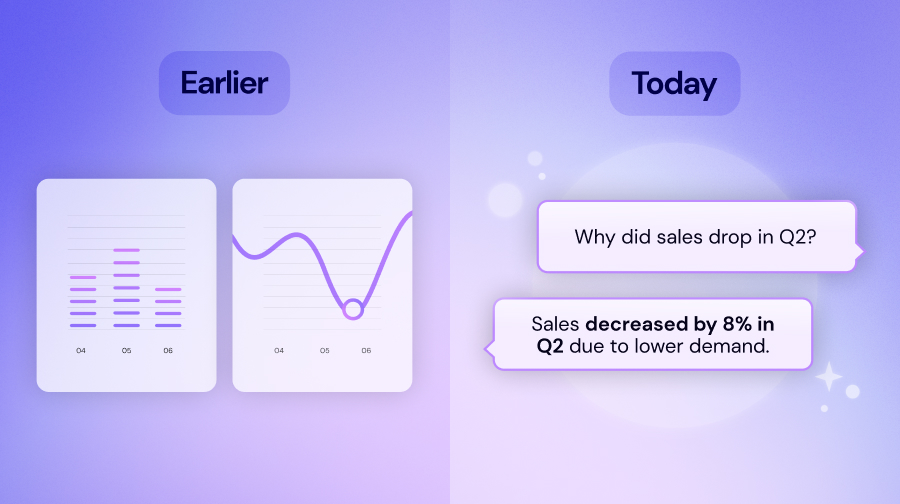In the rapidly evolving landscape of digital tools and platforms, the user interface (UI) plays a crucial role in determining the success and efficiency of a software app. With the advent of AI and LLMs, chatbots have gained significant popularity, especially in the realm of prompting and information retrieval, i.e. asking questions to get quick answers to specific questions at work. However, while chatbots offer several advantages, they are not always the best choice for every scenario. This article explores the strengths and weaknesses of different UIs, with a particular focus on chatbots, and highlights five key scenarios and their ideal UIs.
The spectrum of user interfaces
User interfaces can take many forms, each with its unique strengths:
- Graphical User Interfaces (GUIs): These are visual-based interfaces that rely on graphics, icons, and buttons. They are intuitive and widely used, making them familiar to most users. This is what most software is built with, including your Windows, MacOS, or iOS.
- Command Line Interfaces (CLIs): These text-based interfaces allow users to interact with software by typing commands. They offer powerful functionality for advanced users who know the specific commands.
- Chatbot Interfaces: These AI-driven interfaces simulate conversation with users, providing a natural language way to retrieve information and execute tasks.
- Voice User Interfaces (VUIs): These interfaces allow interaction through speech. They are typically built on top of chatbot interfaces. Because they are hands-free they are convenient for multitasking environments, i.e. while riding a bike.
Chatbot interfaces
Strengths
- Natural language interaction: Chatbots allow users to interact using everyday language, reducing the learning curve.
- Personalized responses: Advanced chatbots can deliver personalized responses based on user history and preferences.
- Scalability: Chatbots can handle multiple queries simultaneously, making them highly scalable.
Weaknesses
- Complexity in handling nuances: Chatbots may struggle with understanding complex or ambiguous queries, leading to frustration.
- Lack of media support: Chatbots are not ideal for displaying data in image, audio or video formats.
- Efficiency: For users who know exactly what they need, navigating through chatbot responses can be slower compared to UI-based search or command-based interactions.
- Learning curve: While natural language is intuitive, learning how to build effective prompts for a chatbot still requires additional training.
Example
Let's look at a specific example where a chatbot may struggle:
- I didn't say he stole my money
(someone else may have said it) - I didn't say he stole my money
(I definitely didn't say it) - I didn't say he stole my money
(I may have implied it in another way) - I didn't say he stole my money
(I didn't say it was him) - I didn't say he stole my money
(he may have just taken it) - I didn't say he stole my money
(it may have been someone else's money) - I didn't say he stole my money
(he may have stolen something lese)
As you can see, our human language includes specific nuances based on how we express ourselves. So far, chatbot's have been failing to understand these nuances reliably.
Top 5 scenarios and the best UIs for each
1. Information research at work
In a workplace setting, employees often need to find specific pieces of information quickly. A well-designed GUI with advanced search capabilities can be far more efficient than a chatbot. Users can leverage filters, categories, and search syntax to pinpoint exactly what they need without the back-and-forth interaction that a chatbot requires. Also, typing a long question often takes longer than just pinching in a few keywords.
2. Data entry and management
For tasks involving extensive data entry or management, GUIs provide structured forms and validation checks that streamline the process. However, for simple data entry such as noting down a task a chatbot or voice interface can be benefitial.
3. Technical troubleshooting
Technical users often prefer CLIs for troubleshooting and diagnostics. The precision and control offered by command-line tools enable them to perform complex tasks more efficiently and most importantly, more reliably, than they could through a chatbot.
4. Customer support and FAQs
In customer support scenarios, chatbots excel by providing instant responses to frequently asked questions. They can handle repetitive queries efficiently, offering a scalable solution that reduces the workload on human agents. Chatbots can quickly provide standard answers and guide users through common troubleshooting steps, making them ideal for this use case.
5. Multitasking environments
In scenarios where users are multitasking, such as in a warehouse or during fieldwork, VUIs can be extremely useful. Voice commands allow users to interact with systems hands-free, increasing productivity and safety.
Conclusion
While chatbots offer a powerful and user-friendly way to interact with software through natural language, they are not always the best choice for every scenario. For tasks such as information research, data entry, technical troubleshooting, and multitasking, other UIs like GUIs and VUIs can be more effective. However, chatbots shine in customer support environments where quick, standardized responses are needed. The key to an ideal knowledge management solution lies in incorporating multiple UI types, each tailored to specific use-cases, to provide the most efficient and user-friendly experience possible. By leveraging the strengths of various interfaces, businesses can empower their employees to access and manage knowledge seamlessly and effectively.












.jpg)


